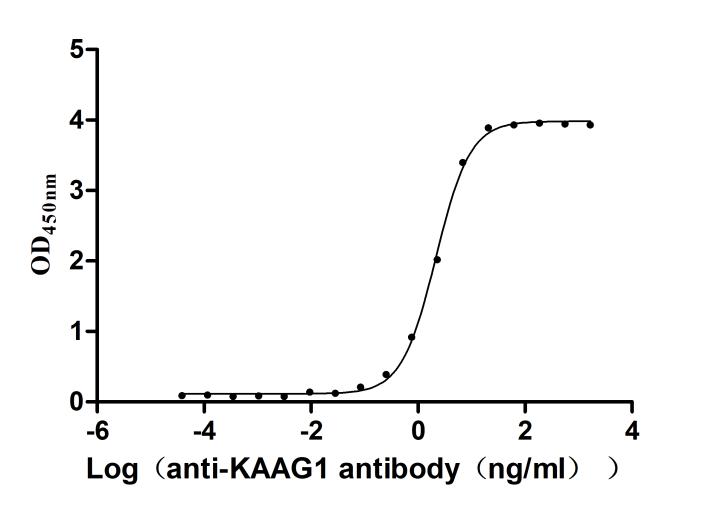Recombinant Mouse Dimethylaniline monooxygenase [N-oxide-forming] 5 (Fmo5)
-
货号:CSB-YP008751MO
-
规格:
-
来源:Yeast
-
其他:
-
货号:CSB-EP008751MO
-
规格:
-
来源:E.coli
-
其他:
-
货号:CSB-EP008751MO-B
-
规格:
-
来源:E.coli
-
共轭:Avi-tag Biotinylated
E. coli biotin ligase (BirA) is highly specific in covalently attaching biotin to the 15 amino acid AviTag peptide. This recombinant protein was biotinylated in vivo by AviTag-BirA technology, which method is BriA catalyzes amide linkage between the biotin and the specific lysine of the AviTag.
-
其他:
-
货号:CSB-BP008751MO
-
规格:
-
来源:Baculovirus
-
其他:
-
货号:CSB-MP008751MO
-
规格:
-
来源:Mammalian cell
-
其他:
产品详情
-
纯度:>85% (SDS-PAGE)
-
基因名:Fmo5
-
Uniprot No.:
-
别名:Fmo5Dimethylaniline monooxygenase [N-oxide-forming] 5; EC 1.14.13.8; Dimethylaniline oxidase 5; Hepatic flavin-containing monooxygenase 5; FMO 5
-
种属:Mus musculus (Mouse)
-
蛋白长度:Full length protein
-
表达区域:1-533
-
氨基酸序列MAKKRIAVIG AGASGLTCIK CCLEEGLEPV CFERSGDIGG LWRFQEAPEE GRASIYQSVV INTSKEMMCF SDYPIPDHYP NYMHNSQVLE YFRMYAKEFD LLKYIQFKTT VCSVKKQPDF STSGQWQVVT ECEGKQQVDV FDGVLVCTGH HTDAHLPLES FPGIEKFKGK YFHSRDYKNP VEFTGKRVIV IGIGNSGGDL AVEISHTAKQ VFLSTRRGAW ILNRVGKHGY PIDLLLSSRI MYYLSRICGP SLKNNYMEKQ MNQRFDHEMF GLKPKHRALS QHPTVNDDLP NRIIAGLVKV KGNVKEFTET AAVFEDGSRE DGIDVVIFAT GYSFAFPFLE DSVKVVKNKV SLYKKVFPPN LEKPTLAIIG LIQPLGAIMP ISELQGRWAT QVFKGLKKLP SQSEMMAEIN KAREEMAKRY VDSQRHTIQG DYIDTMEEIA DLVGVRPNIL PLVFTDPRLA LRLLLGPCTP VQYRLQGPGK WAGARKTILT TEDRVRKPLM TRVVERDSSG GSLVTVRVLM LAVAFFAVIL AYF
-
蛋白标签:Tag type will be determined during the manufacturing process.
The tag type will be determined during production process. If you have specified tag type, please tell us and we will develop the specified tag preferentially. -
产品提供形式:Lyophilized powder
Note: We will preferentially ship the format that we have in stock, however, if you have any special requirement for the format, please remark your requirement when placing the order, we will prepare according to your demand. -
复溶:We recommend that this vial be briefly centrifuged prior to opening to bring the contents to the bottom. Please reconstitute protein in deionized sterile water to a concentration of 0.1-1.0 mg/mL.We recommend to add 5-50% of glycerol (final concentration) and aliquot for long-term storage at -20℃/-80℃. Our default final concentration of glycerol is 50%. Customers could use it as reference.
-
储存条件:Store at -20°C/-80°C upon receipt, aliquoting is necessary for mutiple use. Avoid repeated freeze-thaw cycles.
-
保质期:The shelf life is related to many factors, storage state, buffer ingredients, storage temperature and the stability of the protein itself.
Generally, the shelf life of liquid form is 6 months at -20°C/-80°C. The shelf life of lyophilized form is 12 months at -20°C/-80°C. -
货期:Delivery time may differ from different purchasing way or location, please kindly consult your local distributors for specific delivery time.Note: All of our proteins are default shipped with normal blue ice packs, if you request to ship with dry ice, please communicate with us in advance and extra fees will be charged.
-
注意事项:Repeated freezing and thawing is not recommended. Store working aliquots at 4°C for up to one week.
-
Datasheet :Please contact us to get it.
靶点详情
-
功能:Acts as Baeyer-Villiger monooxygenase on a broad range of substrates. Catalyzes the insertion of an oxygen atom into a carbon-carbon bond adjacent to a carbonyl, which converts ketones to esters. Active on diverse carbonyl compounds, whereas soft nucleophiles are mostly non- or poorly reactive. In contrast with other forms of FMO it is non- or poorly active on 'classical' substrates such as drugs, pesticides, and dietary components containing soft nucleophilic heteroatoms. Able to oxidize drug molecules bearing a carbonyl group on an aliphatic chain, such as nabumetone and pentoxifylline. Also, in the absence of substrates, shows slow but yet significant NADPH oxidase activity. Acts as a positive modulator of cholesterol biosynthesis as well as glucose homeostasis, promoting metabolic aging via pleiotropic effects.
-
基因功能参考文献:
- Fmo5(-)(/)(-) mice have metabolic characteristics similar to those of germ-free mice, indicating that FMO5 plays a role in sensing or responding to gut bacteria. In WT mice, FMO5 is present in the mucosal epithelium of the gastrointestinal tract where it is induced in response to a high-fat diet. PMID: 28646079
- The phenotype of a knockout mouse identifies FMO5 as a regulator of metabolic aging. PMID: 26049045
- The functional activity of Fmo5 was determined. PMID: 17721934
-
亚细胞定位:Microsome membrane. Endoplasmic reticulum membrane.
-
蛋白家族:FMO family
-
组织特异性:Expressed in liver (at protein level). Expressed in the mucosal epithelium of the gastrointestinal tract.
-
数据库链接:
KEGG: mmu:14263
STRING: 10090.ENSMUSP00000029729
UniGene: Mm.385180
Most popular with customers
-
Recombinant Human Claudin-3 (CLDN3)-VLPs (Active)
Express system: Mammalian cell
Species: Homo sapiens (Human)
-
Recombinant Human Interleukin-2 receptor subunit alpha (IL2RA), partial (Active)
Express system: Mammalian cell
Species: Homo sapiens (Human)
-
Recombinant Human C-C chemokine receptor type 6(CCR6)-VLPs (Active)
Express system: Mammalian cell
Species: Homo sapiens (Human)
-
Recombinant Human Kidney-associated antigen 1(KAAG1) (Active)
Express system: E.coli
Species: Homo sapiens (Human)
-
Recombinant Macaca fascicularis Dipeptidase 3(DPEP3) (Active)
Express system: Mammalian cell
Species: Macaca fascicularis (Crab-eating macaque) (Cynomolgus monkey)
-
Recombinant Macaca fascicularis Interleukin 1 receptor accessory protein(IL1RAP), partial (Active)
Express system: Mammalian cell
Species: Macaca fascicularis (Crab-eating macaque) (Cynomolgus monkey)


















